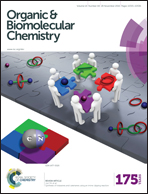An MEDT study of the carbenoid-type [3 + 2] cycloaddition reactions of nitrile ylides with electron-deficient chiral oxazolidinones†
Abstract
The molecular mechanism of the carbenoid-type [3 + 2] cycloaddition (32CA) reactions of a nitrile ylide (NY) with a non-chiral and a chiral oxazolidinone has been studied within Molecular Electron Density Theory (MEDT) at the MPWB1K/6-31G(d) computational level. Topological analysis of the Electron Localisation Function (ELF) of the NY shows that it presents a carbenoid structure. The high nucleophilic character of the NY together with the electrophilic character of the non-chiral oxazolidinone favour a polar 32CA reaction with a very low activation energy, the reaction being completely meta/endo selective. A Bonding Evolution Theory (BET) study of the molecular mechanism makes it possible to characterise a two-stage one-step carbenoid-type mechanism. Non-Covalent Interactions (NCI) analysis of the 32CA reaction between the NY and chiral oxazolidinone correctly explains the diastereoselectivity experimentally observed.
![Graphical abstract: An MEDT study of the carbenoid-type [3 + 2] cycloaddition reactions of nitrile ylides with electron-deficient chiral oxazolidinones](/en/Image/Get?imageInfo.ImageType=GA&imageInfo.ImageIdentifier.ManuscriptID=C6OB01989G&imageInfo.ImageIdentifier.Year=2016)


 Please wait while we load your content...
Please wait while we load your content...